Transformative Learning Through Curriculum Innovation, Mentored Research, and Inclusive Community-Building at Farmingdale State College
Published in:
November 19–20, 2020
Virtual Symposium
At its best, undergraduate education is transformative and liberating (Kahn, 2002; Scott, 2013), broadening the perspectives of students, opening their eyes to new opportunities, and prompting serious reflection about self, values, and community. The Research Aligned Mentorship (RAM) Program is a proven example of powerful transformative learning that is currently changing the lives of 800 low-income, minority, and first-generation students at Farmingdale State College (FSC), SUNY.
Farmingdale State College is located on Long Island, New York, 25 miles east of New York City. As a public institution with relatively low tuition costs, the Farmingdale student population reflects the changing demographic of the US college population. FSC enrolls 10,000 undergraduate students (96% of whom are commuters). Of these, 44% are first-generation college students, 44% are minorities, and 59% are low-income. Such students are far less likely to graduate from college.
The FSC program was launched in 2015 with a $3 million First in the World FIPSE Grant from the US Department of Education. Students selected for the Research Aligned Mentorship Program are drawn exclusively from FSC students who are first-generation, minority, and/or low-income. The overriding goal of the RAM Program was to increase the four-year graduation rate of RAM Scholars by 20 percentage points over the 2015 IPEDS 4-year rate of 20%. The first cohort of 216 RAM Scholars arrived in 2016. Of those students, 199 entered as first-year students. Of those first-year students, 49% graduated within 4 years (29 percentage points over the IPEDS baseline).
The FSC program is the subject of rigorous research. Farmingdale conducts a randomized controlled trial (RCT) that annually selects 400 entering first-generation, minority, and/or low-income first-year students (approximately 220 treatment and 180 control) by applying an algorithm to the database of all entering students who fall into these demographics: first-generation, minority, and/or low-income. Random selection yields a cohort of treatment students (called RAM Scholars) representing a wide range of academic majors and varying records of prior academic achievement. RAM students are drawn from all 42 of FSC’s baccalaureate degree programs in arts and sciences, business, engineering technology, and the health sciences. Unlike well-regarded programs, such as the Meyerhoff Program at the University of Maryland, Baltimore County, FSC’s RAM Scholars do not receive scholarships for their participation
The central research questions guiding this study are:
- What is the impact of participation in the RAM program on annual retention, annual credits earned, GPA, and four-year graduation rates?
- Do impacts vary by level of participation?
There is no single intervention that provides students with a powerful transformative college experience. Instead, it takes a multifaceted effort orchestrated by a capable and caring team. The following conceptual framework of the RAM Program depicts interventions and experiences that are designed to improve persistence, academic success, and four-year graduation rates among RAM Scholars.
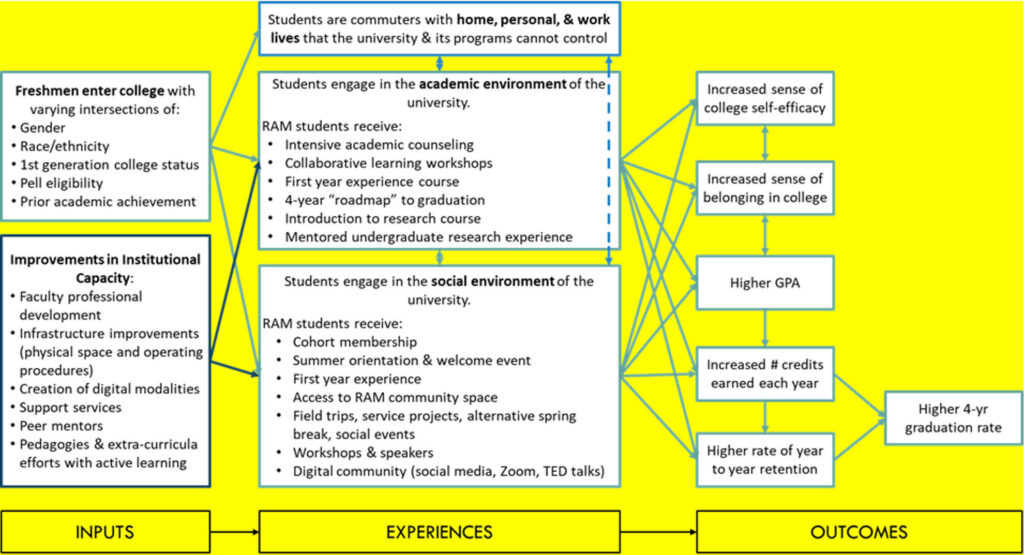
In terms of “inputs,” a supportive infrastructure is essential. Key components of the RAM infrastructure are:
- Physical Space. The RAM Program is centrally located in the college library. The RAM offices include a large conference room used by students throughout the day for study and socializing. Students call it RAM CENTRAL.
- Priority Registration. At many institutions, a barrier to on-time graduation is the fact that required courses are closed by the time the student registers. RAM Scholars avoid that stumbling block because the registrar offers them priority (i.e., first day) registration during all four years.
- Faculty Development. The RAM Program has worked to assure that faculty are provided with professional development opportunities and programs that will help them to become better teachers, research mentors, and allies of RAM Scholars.
In terms of experiences, the RAM Program has concentrated on: 1) curricular innovations (first-year seminars, collaborative learning workshops, introduction to research seminars); 2) powerful mentored research experiences during which students engage in cutting-edge research on-and off-campus; 3) holistic counseling and mentoring over all four years; and 4) community-building programs and service-learning experiences that create “RAMily”—as the students have termed it—among students and RAM staff.
Curricular innovations of the RAM Program include:
- First-Year Seminar: The summer prior to the start of the first year includes counselor meetings with new students and their parents/guardians, an intensive RAM orientation program, and a welcome event with the college president. In the fall, all new RAM Scholars take RAM 101 (First-Year Seminar), which is facilitated by their RAM counselors. This 1-credit course features group work, active listening, and class discussions that prepare students to navigate college. Students also journal weekly and view and discuss TED talks, such as Angela Duckworth’s on grit.
- Collaborative Learning Workshop: Another RAM course is RAM 102, a 1-credit collaborative learning workshop facilitated by the math professors who teach RAM-only sections of statistics and pre-calculus. The collaborative learning workshop is based on the pioneering work of Uri Treisman (1992), who understood that disadvantaged students are able to prosper when assisted in foundational math courses.
- Additional Engaged Pedagogy Experiences: The program arranges for small sections of engaged pedagogy courses reserved exclusively for RAM students (e.g., an integrated introduction biology lecture and lab for majors; learning communities synchronized around a common theme).
- Introduction to Research: Instead of thrusting students into the research setting without much preparation, all RAM Scholars enroll in RAM 201 (Introduction to Research) in their sophomore year. Taught by the RAM Directors, this 1-credit course covers how to locate and read research articles, prepare a research proposal, and understand research ethics. All students complete an IRB-compliant training in research with human subjects. Ancillary workshops are offered on how to apply for NSF-REUs and other competitively funded programs.
Mentored Research Experiences
The culminating experience of the RAM Program is the placement of each RAM Scholar in a research experience on or off campus. This credit-bearing placement (which carries the curricular designation of RAM 303) gives the Scholar a high-impact hands-on learning experience (e.g., an NSF research experience for undergraduates, a business internship, or working side-by-side on campus with a faculty research mentor). The directors have created a detailed RAM research guidebook that is shared with students, faculty mentors, and off-campus supervisors and research mentors. The guidebook requires that the student complete a detailed agreement with the mentor, maintain a log of hours and activities, prepare weekly reflections on the learning experience, and respond to various prompts about their experience as part of mid-term and final evaluations. Students are encouraged to join their research mentors in proposing to submit a poster or paper at professional conferences.
The RAM directors work diligently to secure research placements for RAM Scholars by conducting one-on-one interviews with over 150 FSC faculty researchers and by building relationships with researchers at other universities and laboratories and with businesses. Each option is profiled in a database available to students. To date, from fall 2017 through summer 2020, 301 RAM Scholars have participated in mentored research—181 in on-campus placements with faculty mentors and 120 in off-campus placements. RAM Scholars have also been awarded competitive, funded research opportunities at distinguished placements that include University of California-Berkeley, Brookhaven National Labs, Rutgers, University of Nebraska, the City University of New York, and University of Nairobi in Kenya. Needless to say, the RAM intervention of mentored research outside of the traditional classroom offers a truly transformative learning experience.
Holistic counseling and mentoring over four years
The RAM Program has instituted an intensive type of counseling that includes much more than academic advisement. RAM students are required to meet with their RAM counselor at least two times each semester during years one and two, and at least once per semester during years three and four. This program is successful in helping students navigate the complexities of higher education and in addressing the weak sense of belonging and lower self-efficacy that is often associated with first-generation, low-income, and minority students. The bond created between the counselor and first-year Scholar is strong because students are assigned a counselor according to their major, and that counselor meets with advisees weekly during the fall while teaching the RAM 101 seminar. The result of this strong bond is that first-year students actually elect to schedule one-on-one appointments with their RAM counselor not only for the two times that are required, but on average six times a semester.
During their second year the students transition to their new counselor, either the director or the assistant director of the program. These counselors, who also are the instructors for the 1-credit RAM 201 (Introduction to Research), prepare their advisees for their research experiences and help them with post-graduation plans. Majors in STEM or health professions work with the director (who holds a PhD in biology) and non-STEM majors with the assistant director (who has a social science background and a PhD in Education).
Community-Building Programs and Service-Learning Experiences
Because almost all RAM Scholars are commuter students who live with family, the RAM Program strives to nurture in its students the sense of community and engagement that students at residential institutions come by naturally. RAM Scholars are encouraged to join FSC clubs and student government. During the summer Kick-Off Orientation, students play a raucous game of “RAMily Feud.” There are speakers, social events, workshops, film nights, and parties throughout the year. Two years ago, “RAMdom Acts of Service” was launched, giving students monthly opportunities for community engagement and service (e.g., beach and highway clean up, volunteering for Cancer Walks, serving food at homeless shelters). Another powerful service experience is the Alternative Spring Break program, through which 25 students spend their vacation working for Habitat for Humanity out of state. Lasting friendships and bonds between students and RAM staff are forged by such an intense experience away from home and family. Engagement and RAMily are important ingredients that contribute to student persistence.
From this description of the RAM Program and its emphasis on active pedagogy, student engagement, and high-impact practices relating to retention, it should be obvious that the program’s design owes a debt of gratitude to a great number of academic analysts and thinkers. Most prominent are Tinto (1975, 1987), Bean (1982), Astin (1984), Pascarella (1980), Aljohani (2016), Upcraft et al. (2015), and Kuh (2008).
Summary of Assessment Methods and Program Outcomes
Since fall of 2016, there have been four cohorts of students in the RAM Program (839 students assigned to the RAM treatment group and 623 non-RAM control group students). This study used mixed methods to collect and interpret qualitative and quantitative data from multiple sources in order to understand both the impact of the RAM program on participants, as well as the efficacy of the program model. Institutional records provided data on year-to-year retention, annual GPA, annual credits earned, and graduation status, as well as student gender, race/ethnicity, first-generation college status, prior academic achievement, and Pell eligibility status.
While the sophisticated methods and detailed analysis conducted by the outside evaluator, Dr. Kate Winter, cannot be fully presented here, a few simple charts convey the effectiveness of the RAM Program.
First, RAM Scholars in Cohort 1 (who entered as first-year students in fall 2016) had a statistically higher four-year graduation rate than students in the control group:

Second, RAM Scholars persist at a higher rate than the control group students:
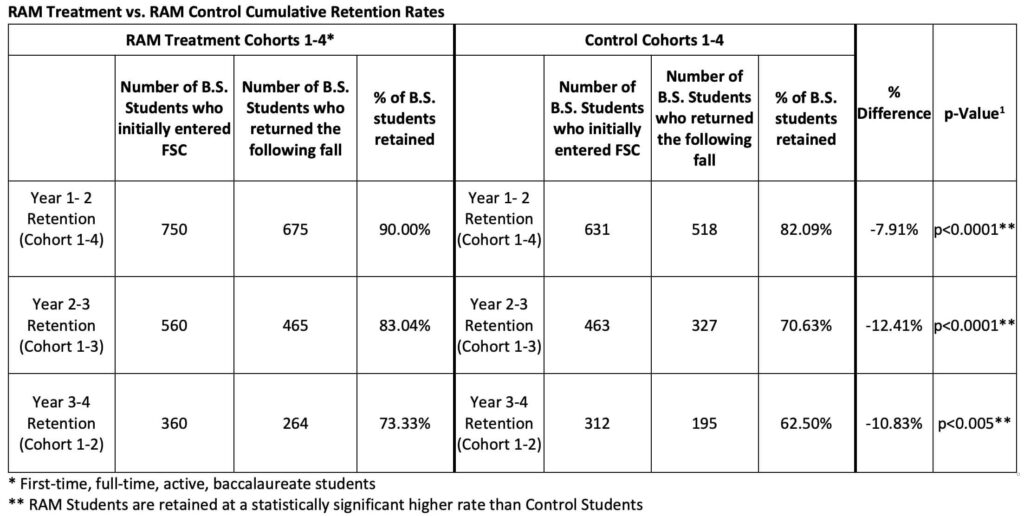
Third, students who actively participated in RAM treatments were more likely than students who did not participate to perform better in their first three years of coursework (according to annual GPA), to earn more credits each year, to return the subsequent year, and to graduate within four years. Increases in participation were associated with a 20% increase in the likelihood of being on track to graduate within four years for each of the first three years of participation. Additionally, students who continued to engage closely with the RAM program after the first two years were more likely to do better in their final two years and, ultimately, to graduate on time.
Fourth, from the institutional perspective, the superior retention of RAM Scholars compared with the overall FSC student population has produced increased tuition revenues for the College. As depicted in the following table, the value of additional tuition revenues collected (2017-2020) totaled $1,011,811.

The RAM Program has proven to be cost-effective. Noting this result—and persuaded by the statistically significant better performance of RAM Scholars as well as impressed by the distinctive RAM Scholar achievements in research and other accomplishments—the FSC president and provost have determined that the RAM Program will remain an ongoing component of the College. Indeed, it is one of the most distinctive and much-lauded aspects of the education provided by Farmingdale State College.
Lessons Learned
This study establishes that minority, low-income, and first-generation college students—who disproportionately fail to complete college—thrive and succeed when they experience a carefully orchestrated four-year program that engages them in curricular and extracurricular programs and activities. The following list identifies key lessons learned from the success of the RAM Program at Farmingdale State College:
- Second-tier public institutions can change the lives and trajectories of their low-income, first-generation, and minority students.
- The more opportunities for academic and social engagement that are provided, the greater the impact on student persistence and success.
- The first two years are key.
- Holistic advising and counseling across all four years are important.
- Creating a family-like atmosphere is hard work, but clearly pays off with superior year-to-year retention.
- Embedding a program in the academic curriculum is beneficial.
- Institutions can implement effective programs without awarding scholarships.
- Mentored, hands-on research is powerful and often transformative and need not be restricted to honor students.
- Early and continued buy-in from the college community—often achieved through the constant college-wide communication of program accomplishments—is important for the success and institutionalization of a new program.
Conclusion
The RAM Program at Farmingdale State College in New York was born as an answer to a difficult question: What can be done to raise the four-year graduation rate of underrepresented minority, first-generation, and low-income college students? The multifaceted RAM Program has proven effective in advancing the academic success and graduation rates of students who are traditionally underserved by US higher education. The Research Aligned Mentorship Program is transforming the lives of students. It is a proven example that can be replicated by institutions across the US—especially by second-tier public institutions like Farmingdale that educate the majority of our nation’s minority, low-income, and first-generation college students.

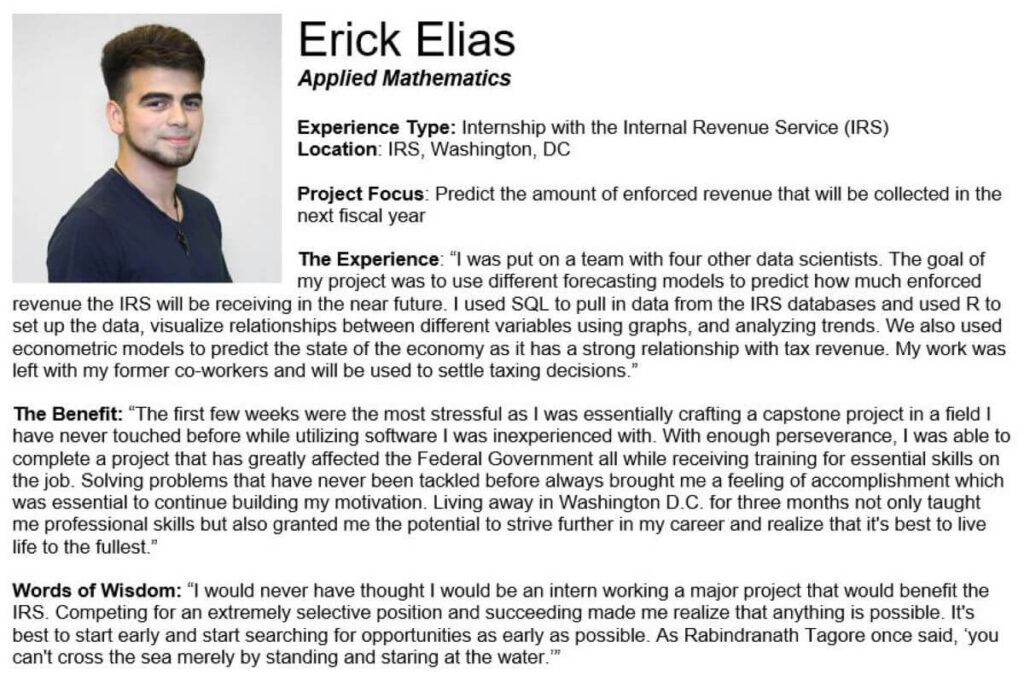
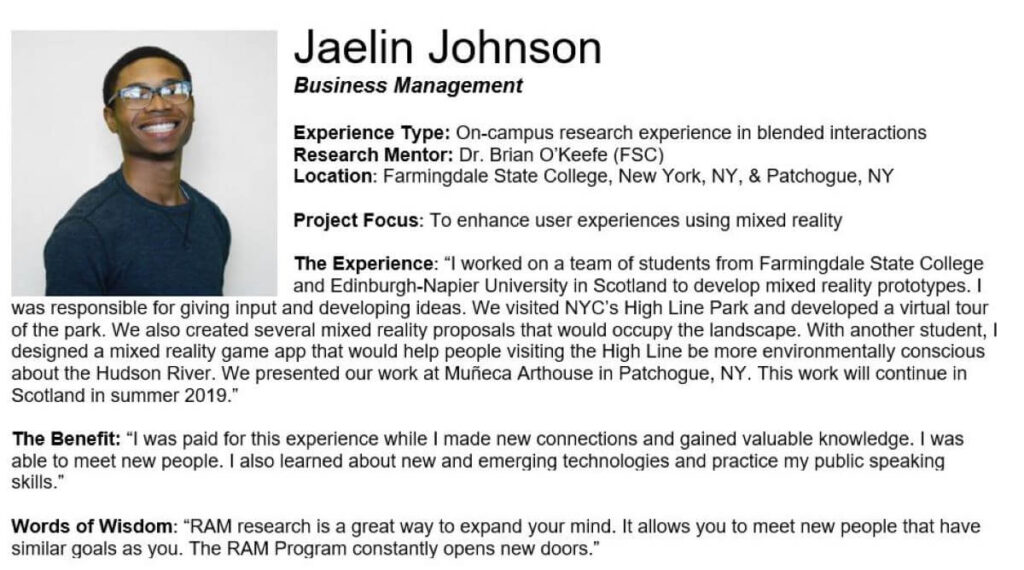
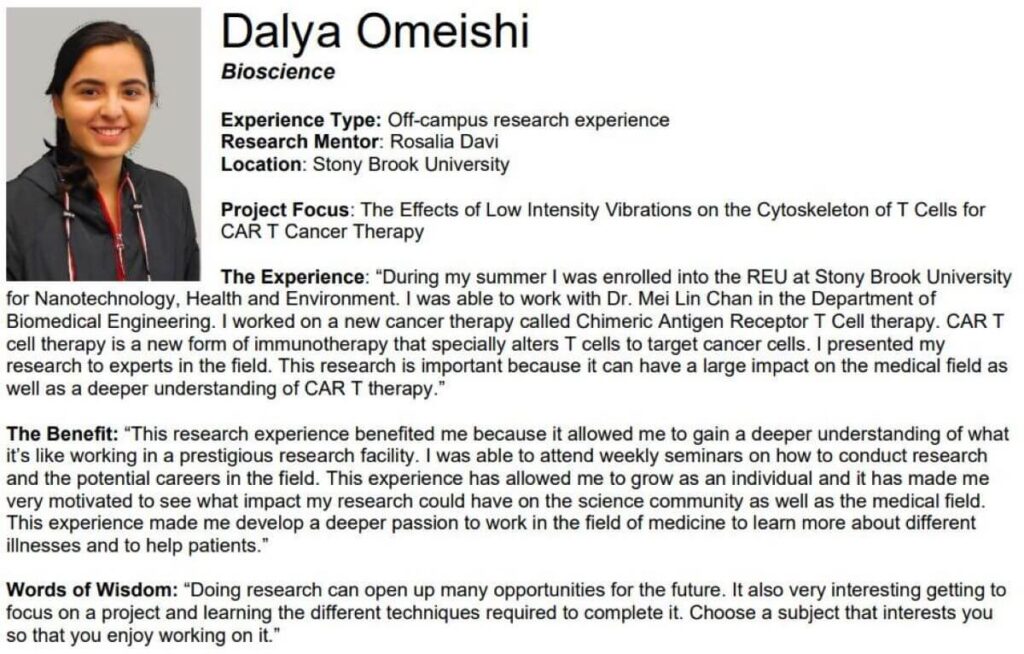
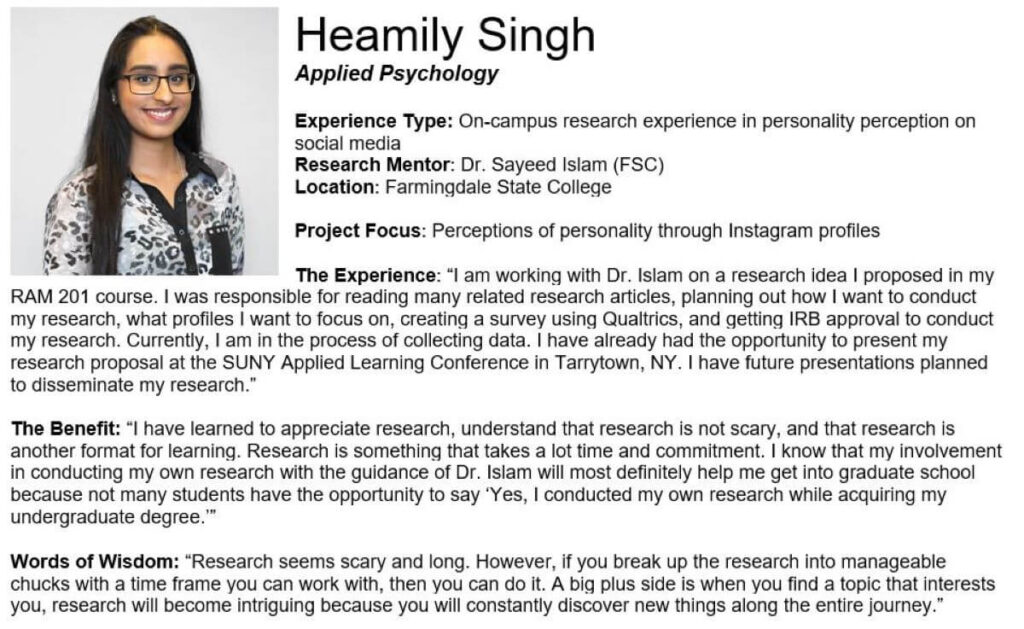
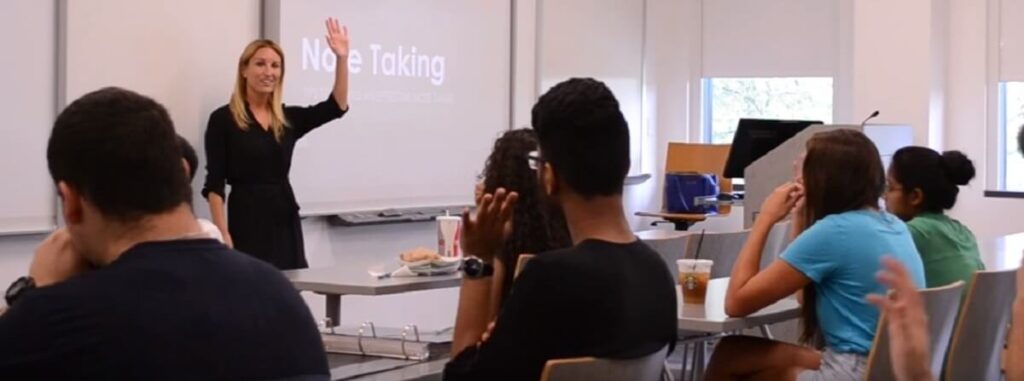
References
Aljohani, O. (2016). A Comprehensive Review of the Major Studies and Theoretical Models of Student Retention in Higher Education. Higher Education Studies, 6(2), 1. https://doi.org/10.5539/hes.v6n2p1
Astin, A. W. (1984). Student Involvement: A developmental theory of higher education. Journal of College Student Personnel, 25, 297–308.
Bean, J. P. (1982). Student attrition, intentions, and confidence: Interaction effects in a path model.
Duckworth, A. L. (2013). Grit: The power of passion and perseverance. TED Talk. https://www.ted.com/talks/angela_lee_duckworth_grit_the_power_of_passion_and_perseverance?language=en
Kahn, B. L. (2002). Co-opting the Marketplace in Service of Liberal Arts Education. Liberal Education, 88(1), 54–58. https://www.aacu.org/publications-research/periodicals/co-opting-marketplace- service-liberal-arts-education
Kuh, G. D. (2008). High-Impact Educational Practices: What They Are, Who Has Access to Them, and Why They Matter. Association of American Colleges & Universities.
Pascarella, E. T. (1980). Student-Faculty Informal Contact and College Outcomes. Review of Educational Research, 50(4), 545–595. https://doi.org/10.3102/00346543050004545
Scott, R. A. (2013). Thoughts on a “Liberating” Education. Liberal Education, 99(4). https://www.aacu.org/publications-research/periodicals/thoughts-liberating-education
Tinto, V. (1975). Dropout from Higher Education: A Theoretical Synthesis of Recent Research. Review of Educational Research, 45(1), 89. https://doi.org/10.2307/1170024
Tinto, V. (1987). Leaving College: Rethinking the Causes and Cures of Student Attrition (1st ed.). University of Chicago Press. https://www.amazon.com/Leaving-College-Rethinking-Student- Attrition/dp/0226804496
Treisman, U. (1992). Studying Students Studying Calculus: A Look at the Lives of Minority Mathematics Students in College. The College Mathematics Journal, 23(5), 362. https://doi.org/10.2307/2686410
Upcraft, M. L., Gardner, J., & Barefoot, B. (2015). Challenging and Supporting the First-Year Student: A Handbook for Improving the First Year of College. Jossey-Bass.
US Department of Education. (n.d.). First in the World Program. https://www2.ed.gov/programs/fitw/index.html
Spring 2021: Curriculum Innovation for Transformative Learning
